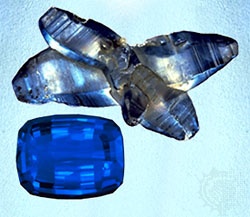sapphire
gemstone
 transparent to translucent, natural or synthetic variety of corundum (q.v.; aluminum oxide, Al2O3) that has been highly prized as a gemstone since about 800 BC. Its colour is due mainly to the presence of small amounts of iron and titanium and normally ranges from a very pale blue to deep indigo, with the most valued a medium-deep cornflower blue. Colourless, gray, yellow, pale pink, orange, green, violet, and brown varieties of gem corundum also are known as sapphire; red varieties are called ruby. Much sapphire is unevenly coloured; it is also dichroic; that is, the colour of most varieties changes with the direction of view. Alexandrite sapphire appears blue in daylight and reddish or violet in artificial illumination, somewhat like true alexandrite. Careful heating and cooling under various conditions can induce permanent colour changes in sapphire (e.g., from yellow to colourless or greenish blue and from violet to pink). Other colour changes result from exposure to intense radiation. Most sapphire contains abundant microscopic inclusions; reflections from these yield a faint whitish sheen, known as silk. Tiny, regularly arranged mineral inclusions (commonly rutile) and elongate cavities are responsible for the asterism shown by star sapphire.
transparent to translucent, natural or synthetic variety of corundum (q.v.; aluminum oxide, Al2O3) that has been highly prized as a gemstone since about 800 BC. Its colour is due mainly to the presence of small amounts of iron and titanium and normally ranges from a very pale blue to deep indigo, with the most valued a medium-deep cornflower blue. Colourless, gray, yellow, pale pink, orange, green, violet, and brown varieties of gem corundum also are known as sapphire; red varieties are called ruby. Much sapphire is unevenly coloured; it is also dichroic; that is, the colour of most varieties changes with the direction of view. Alexandrite sapphire appears blue in daylight and reddish or violet in artificial illumination, somewhat like true alexandrite. Careful heating and cooling under various conditions can induce permanent colour changes in sapphire (e.g., from yellow to colourless or greenish blue and from violet to pink). Other colour changes result from exposure to intense radiation. Most sapphire contains abundant microscopic inclusions; reflections from these yield a faint whitish sheen, known as silk. Tiny, regularly arranged mineral inclusions (commonly rutile) and elongate cavities are responsible for the asterism shown by star sapphire.Sapphire is a primary constituent of many igneous rocks, especially syenites, pegmatites, and various basic (silica-poor) types; it also occurs in schists and metamorphosed carbonate rocks. Most commercial production has come from alluvial gravels and other placer deposits, where the sapphire commonly is associated with ruby and other gem minerals. The best known sources, including some lode deposits, are in Sri Lanka, Myanmar (Burma), Thailand, Australia (Victoria, Queensland, New South Wales), India, Madagascar, Russia, South Africa, and the United States (Montana, North Carolina).
Most transparent sapphire is faceted, generally in the brilliant style. Such gems have considerable sparkle, but they exhibit little fire because of their modest dispersion (separation of light into its component colours). Skillful cutting of unevenly coloured stones yields gems with a uniform appearance derived from only small portions of relatively deep colour. Star sapphire and other nontransparent varieties are cut en cabochon (in convex form, highly polished) rather than faceted. Despite its great hardness, some sapphire is carved or engraved, especially in the Orient.
Synthetic sapphire has been produced commercially since 1902. Clear, sound material is manufactured in the form of carrot-shaped boules and slender rods. Much is consumed by the jewelry trade, but most synthetic material is used for the manufacture of jewel bearings, gauges, dies, phonograph-needle points, thread guides, and other specialized components; some also is used as a high-grade abrasive. Synthetic star sapphire is made with luminous stars that are more regular and distinct than those in most natural stones; the asterism is obtained through controlled exsolution of impurities.
- relative volumes occupied by some cellular compartments in a typical liver cell
- relativistic mass
- relativistic mechanics
- relativity
- relaxation phenomenon
- relaxin
- relay
- relay race
- R.E. Lee: Letter of Resignation
- Reles, Abe
- relic
- relief
- relief printing
- religion
- religion, philosophy of
- religions, classification of
- religion, study of
- Religious Adherents in the United States of America, 1900-2005
- Religious Adherents in the United States of America, 1900-2005 1
- Religious Adherents in the United States of America, 1900-2005 2
- Religious Adherents in the United States of America, 1900-2005 3
- Religious Adherents in the United States of America, 1900-2005 4
- Religious Adherents in the United States of America, 1900-2005 5
- Religious Adherents in the United States of America, AD 1900-2000
- Religious Adherents in the United States of America, AD 1900-2000 1